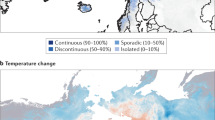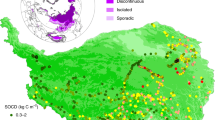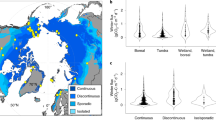Abstract
Permafrost soils contain an estimated 1,700 Pg of carbon, almost twice the present atmospheric carbon pool1. As permafrost soils thaw owing to climate warming, respiration of organic matter within these soils will transfer carbon to the atmosphere, potentially leading to a positive feedback2. Models in which the carbon cycle is uncoupled from the atmosphere, together with one-dimensional models, suggest that permafrost soils could release 7–138 Pg carbon by 2100 (refs 3, 4). Here, we use a coupled global climate model to quantify the magnitude of the warming generated by the feedback between permafrost carbon release and climate. According to our simulations, permafrost soils will release between 68 and 508 Pg carbon by 2100. We show that the additional surface warming generated by the feedback between permafrost carbon and climate is independent of the pathway of anthropogenic emissions followed in the twenty-first century. We estimate that this feedback could result in an additional warming of 0.13–1.69 °C by 2300. We further show that the upper bound for the strength of the feedback is reached under the less intensive emissions pathways. We suggest that permafrost carbon release could lead to significant warming, even under less intensive emissions trajectories.
This is a preview of subscription content, access via your institution
Access options
Subscribe to this journal
Receive 12 print issues and online access
$259.00 per year
only $21.58 per issue
Buy this article
- Purchase on Springer Link
- Instant access to full article PDF
Prices may be subject to local taxes which are calculated during checkout



Similar content being viewed by others
References
Tarnocai, C. et al. Soil organic carbon pools in the northern circumpolar permafrost region. Glob. Biogeochem. Cycles 23, GB2023 (2009).
Schuur, E. A. G. et al. Vulnerability of permafrost carbon to climate change: Implications for the global carbon cycle. BioScience 58, 701–714 (2008).
Zhuang, Q. et al. Co2 and CH4 exchanges between land ecosystems and the atmosphere in northern high latitudes over the twenty first century. Geophys. Res. Lett. 33, L17403 (2006).
Schaefer, K., Zhang, T, Bruhwiler, L. & Barrett, A. P. Amount and timing of permafrost carbon release in response to climate warming. Tellus 63B, 165–180 (2011).
Avis, C. A., Weaver, A. J. & Meissner, K. J. Reduction in areal extent of high-latitude wetlands in response to permafrost thaw. Nature Geosci. 4, 444–448 (2011).
Hegerl, G. C. et al. in Climate Change 2007: The Physical Science Basis (eds Solomon, S. et al.) (Cambridge Univ. Press, 2007).
Moss, R. H. et al. The next generation of scenarios for climate change research and assessment. Nature 463, 747–754 (2010).
Koven, C. D. et al. Permafrost carbon–climate feedbacks accelerate global warming. Proc. Natl Acad. Sci. USA 108, 14769–14774 (2011).
Schneider von Deimling, T. et al. Estimating the near-surface permafrost-carbon feedback on global warming. Biogeosciences 9, 649–665 (2012).
Luke, C. M. & Cox, P. M. Soil carbon and climate change: from the Jenkinson effect to the compost–bomb instability. Eur. J. Soil Sci. 62, 5–12 (2011).
Weaver, A. J. et al. The UVic Earth System Climate Model: Model description, climatology, and applications to past, present and future climates. Atmosphere–Ocean 39, 1–67 (2001).
Schmittner, A., Oschlies, A., Matthews, H. D. & Galbraith, E. D. Future changes in climate, ocean circulation, ecosystems, and biogeochemical cycling simulated for a business-as-usual Co2 emission scenario until year 4000 AD. Glob. Biogeochem. Cycles 22, GB1013 (2008).
Matthews, H. D., Weaver, A. J., Meissner, K. J., Gillett, N. P. & Eby, M. Natural and anthropogenic climate change: Incorporating historical land cover change, vegetation dynamics and the global carbon cycle. Clim. Dynam. 22, 461–479 (2004).
Zickfeld, K., Eby, M., Matthews, H. D. & Weaver, A. J. Setting cumulative emissions targets to reduce the risk of dangerous climate change. Proc. Natl Acad. Sci. USA 106, 16129–16134 (2008).
Acknowledgements
The authors are grateful to NSERC for support in the form of CGS fellowships awarded to A.H.M.D. and C.A.A., as well as a Discovery Grant awarded to A.J.W.
Author information
Authors and Affiliations
Contributions
A.H.M.D., A.J.W. and C.A.A. formulated the model experiments and wrote the paper. A.H.M.D. performed modifications to the ESCM, conducted experiments and analysed the results.
Corresponding author
Ethics declarations
Competing interests
The authors declare no competing financial interests.
Supplementary information
Supplementary Information
Supplementary Information (PDF 1359 kb)
Rights and permissions
About this article
Cite this article
MacDougall, A., Avis, C. & Weaver, A. Significant contribution to climate warming from the permafrost carbon feedback. Nature Geosci 5, 719–721 (2012). https://doi.org/10.1038/ngeo1573
Received:
Accepted:
Published:
Issue Date:
DOI: https://doi.org/10.1038/ngeo1573
This article is cited by
-
Earth system models must include permafrost carbon processes
Nature Climate Change (2024)
-
Accounting for the climate benefit of temporary carbon storage in nature
Nature Communications (2023)
-
Temporary nature-based carbon removal can lower peak warming in a well-below 2 °C scenario
Communications Earth & Environment (2022)
-
Climate warming over 1961–2019 and impacts on permafrost zonation in Northeast China
Journal of Forestry Research (2022)
-
Timescales of the permafrost carbon cycle and legacy effects of temperature overshoot scenarios
Nature Communications (2021)



